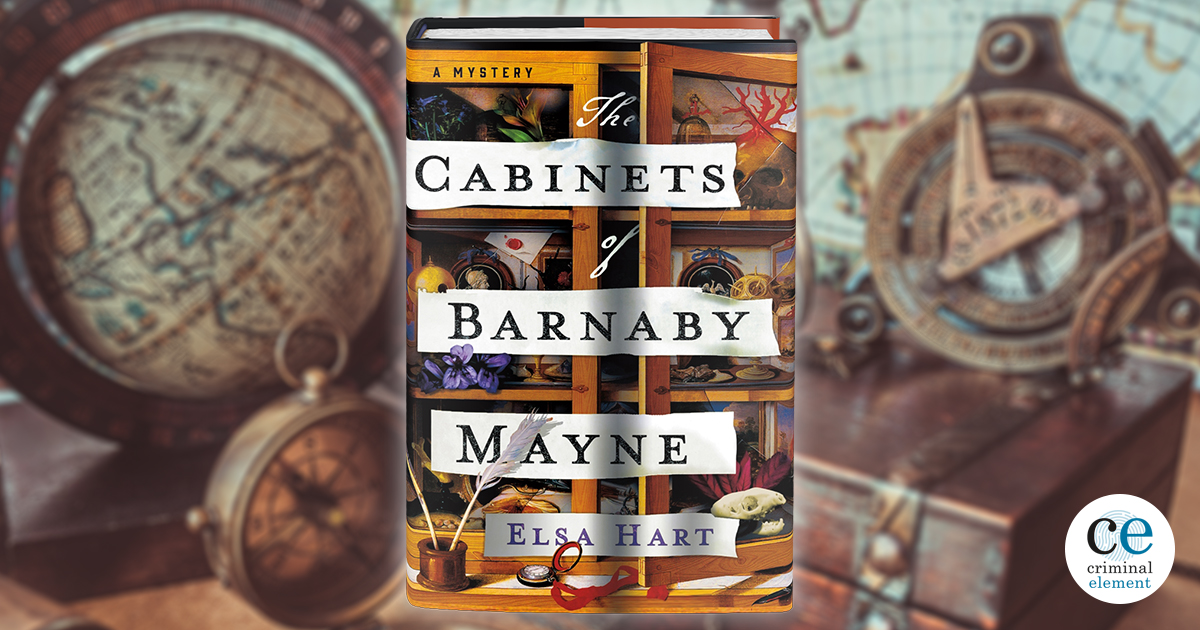Book Review: The Cabinets of Barnaby Mayne by Elsa Hart
By Janet Webb
August 5, 2020
The time is 1703, the dawn of a new century. Amateur botanist Lady Cecily Kay has traveled from Smyrna to London. Her diplomat husband encouraged her to leave Turkey; theirs is not an amicable marriage. Cecily has arranged to stay in London at the house of noted collector Sir Barnaby Mayne. Access to his research tomes and plant collection will help her categorize her personal specimens. Cecily’s first encounter with the Mayne household shows that she’s a proponent of the scientific method, which is “a method of procedure that has characterized natural science since the 17th century, consisting in systematic observation, measurement, and experiment, and the formulation, testing, and modification of hypotheses.” Translated—practitioners of the scientific method don’t miss much.
When Cecily knocks on Sir Barnaby’s door, “the first sound to reach her from within was of shattering glass.” A maid lets her in and Cecily’s “keen nose” smells a “sharp odor.” She commiserates with the flustered young maid, saying, “A broken specimen jar?” How did she know?
“Spiritu vini,” she said. “I must assume that in the home of one of the most esteemed collectors in England, the smell of strong alcohol at midday may be attributed not to afternoon carousing, but to the project of preservation. That, in combination with the sound of breaking glass—I hope no one has been injured?”
Sir Barnaby’s house is more museum than gentleman’s residence. In the room dedicated to the study of stones, “every inch of oaken shelf and every tabletop from corner to corner—was covered in stones.” Each rock is “tagged with a red paper label.” A civilian aka not-a-collector might be daunted by the audacity and breadth of Sir Barnaby’s collections but not Cecily: “The thought of all that awaited her in the rooms beyond filled her with anticipation.” She is sympathetic to Sir Barnaby’s need to display all that he owns.
Their first meeting is less than cordial: she is reprimanded for arriving early. Before she retreats to her room, she sees a foreign visitor accidently destroy a vipermouth, a rare fish. Sir Barnaby shoos her off, not before telling her to return for a tour of his collection at 2:30 pm, saying, “I insist on punctuality.”
Cecily’s bedchamber is highly unusual.
The guest bedroom that was to be Cecily’s home for a week appeared to prioritize the comfort of the collection over that of a person. The laden shelves that lined its wall were free of dust and soot, while the blue velvet curtains around the bed were faded and moth-eaten.
Surrounded by shells, sea urchins and fish skeletons, Cecily is unperturbed: she has other fish to fry. During her exploration of the upper floors, she encounters a childhood friend and schoolmate, Meacan, now Meacan Barlow. Meacan’s father had been “one of the most respected gardeners in England.” He became close to Cecily’s father, a generous philosophical man, when he and his family lived on the Goodrick estate.
So it was that while their fathers sketched parterres and debated the placement of trees, Cecily and Meacan became first classmates, then friends.
Why is Cecily here, wonders Meacan. When Cecily speaks of Sir Barnaby’s comprehensive “repository of dried specimens and botanical books,” Meacan, speaking as only as old friend of twenty-five years can, calls her out.
“So you are one of them.”
“Them?”
Meacan tucked her chin, narrowed her eyes, and pressed her lips together in a caricature of Sir Barnaby. “The collectors,” she intoned. “The noble scholars. Finding God’s Truth in the veins of leaves and scales of lizards and colors of shells. Arranging them all into little piles. Giving them names no one can remember.” She relaxed her expression, returned to the desk, and tapped a finger on a half-finished sketch. “Not that I resent it. You enthusiasts keep the poor artists employed.”
Cecily connected Meacan’s words to the pencil shavings and the paintbrush. “You’re an illustrator?”
“A sought-after illustrator,” said Meacan, with pride. “Currently in Sir Barnaby’s employ. He intends to publish another catalogue of his most wondrous wonders.”
Cecily is punctual for Sir Barnaby’s tour. He and his hapless curator, Walter Dinley, greet the guests—Humphrey Warbulton, Doctor Giles Inwood, Miss Alice Fordyce (a surprise attendee), and Martin Carlyle. Unusually, Sir Barnaby slips away from the tour before it ends. When the collectors go in search of him, they find him tumbled on the floor of his private sanctuary. Holding a knife in his hand, Walter Dinley confesses to murdering Sir Barnaby.
Cecily turned back to the room. Inwood had dropped to his knees beside Sir Barnaby. She watched his fingers move with practiced assurance from the fallen man’s wrist to his lips. The physician’s shoulders slumped. She knew before he spoke that Sir Barnaby Mayne was dead.
Dinley flees and the collective opinion is that he’s guilty. Does Lady Cecily Kay agree? Not necessarily and she employs the scientific method to investigate every possibility, particularly, who will inherit Sir Barnaby’s esteemed collection? Cecily, an 18th century Sherlock Holmes, has a Doctor Watson in the person of Meacan Farlow. To paraphrase, the ladies get the job done, with the assistance of a shadowy figure, Signore Covo. Covo is a trusted intermediary between collectors and those who want to sell their treasures. The London of 1703 makes a dank, dangerous, and exciting backdrop to Cecily and Meacan’s inquiries. The Cabinets of Barnaby Mayne is the first of a new series. Brava Elsa Hart.
Postscript: If you visit the British Museum in London (virtually these days), you will witness how one man’s passion for collecting sparked a reverence for scientific knowledge. Sir Hans Sloane is famous for “bequeathing his collection of 71,000 items to the British nation, thus providing the foundation of the British Museum, the British Library and the Natural History Museum, London,” Wikipedia.
